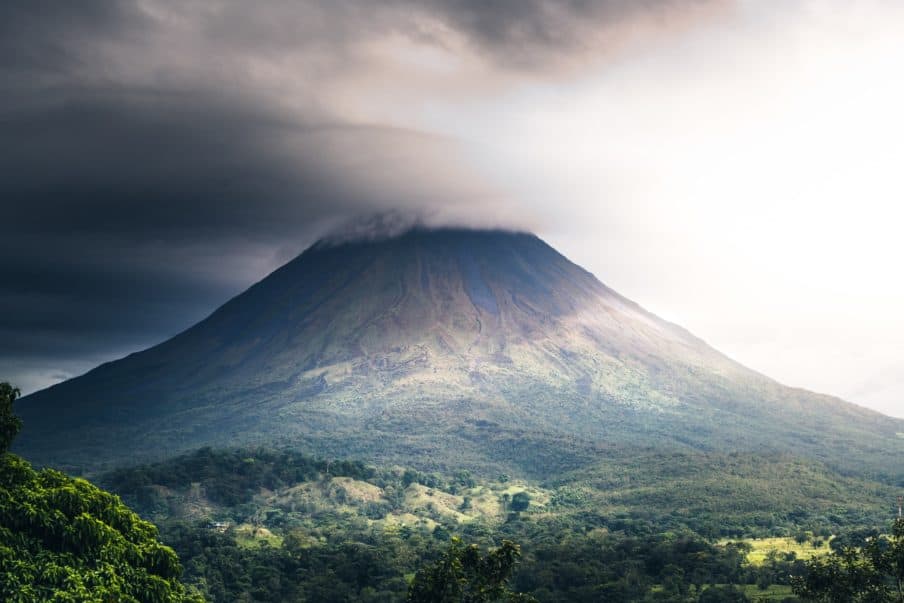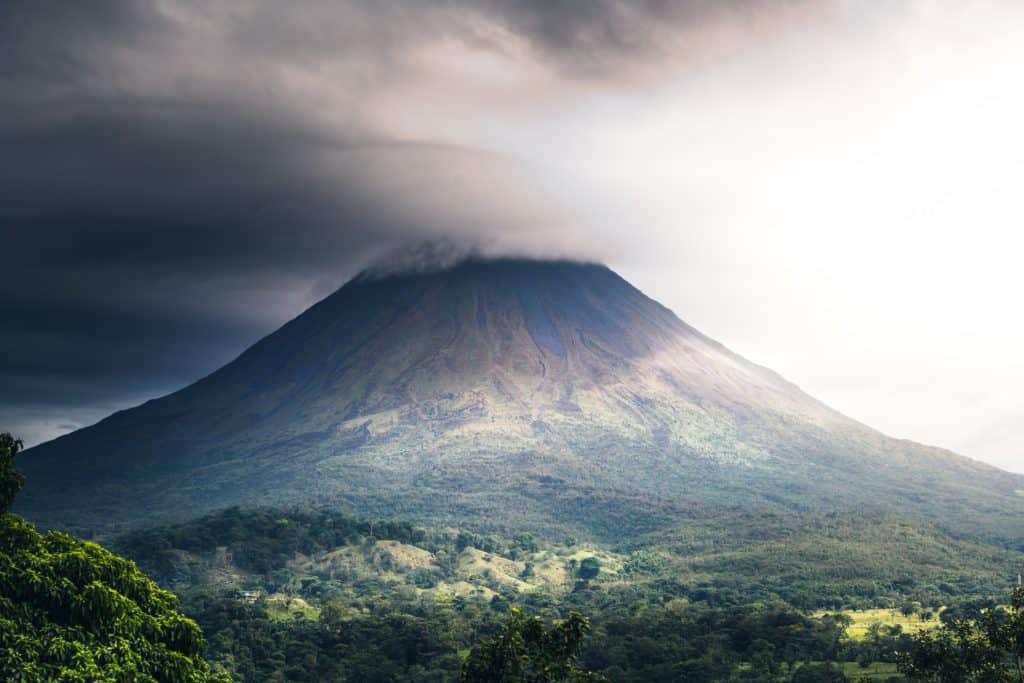
Costa Rica is home to several active volcanoes bur the seven volcanoes you must see in Costa Ricar are:
- Irazu – Volcano known for its large crater and several vents and is the highest in Costa Rica.
- Poas – Volcano known for its active crater that holds a beautiful, turquoise-colored lake and its eruptions of ash and steam.
- Rincon de la Vieja – Volcano in Guanacaste known for its fumaroles, mudpots, and hot springs.
- Barva – An inactive volcano located in the Central Valley of Costa Rica, and part of the Braulio Carrillo National Park
- Tenorio – An inactive volcano located in the Guanacaste and is part of the Rincon de la Vieja National Park.
- Turrialba – Active volcano known for its ash eruptions and occasional explosive activity
- Arenal – located in the north-central and known for its almost perfect conical shape.
These volcanoes offer many opportunities for hiking, birdwatching, and wildlife viewing. Visitors can also take guided tours to see the volcano’s activity, including night-time lava flows and ash eruptions.
Did you know that there are well over 175 identifiable volcanic formations, some of which have a measure of volcanic activity but are not considered active? You may be surprised to find that there’s a lot more about visiting a volcano in Costa Rica than you first imagined.
The excitement of seeing a volcano happens when the mist clears and you get your first glimpse of a conical shape volcano like Arenal Volcano the deep crater of the Poas Volcano. Once you see it, it will not be something you or your kids will not soon forget.
The experience of seeing a volcano may not be like the one you saw on TV or the ones you see on Facebook and Instagram. But, that’s okay! The effect will be different for both you and your kids.
Let’s go into more detail on each one of these volcanoes!
The 7 Best Volcanoes to See in Costa Rica
1. Irazu Volcano
Volcan Irazu, or simply Irazu, is an active volcano located on the Cordillera mountain range in central Costa Rica, near the city of Cartago. Its name is thought to have been a combination of “ara”, or point, and “tzu”, or thunder.
Others believe the name came from an indigenous village located close to the volcano, which is named Iztaru. Whatever the origins of its name were, Irazu is more popularly known by the locals for its other name, “El Coloso”, which means “The Colossus”.
It was given the nickname due to the catastrophic eruptions it was known for in the past. It was also given that name due to its immense size, with a summit 11,260 feet above sea level. This makes Irazu the tallest active volcano in Costa Rica. In fact, if you stand at the summit, it’s possible to see both the Atlantic Ocean and the Pacific Ocean on a clear day.
Irazu is known to have multiple craters on its surface, with the more popular one being Diego de la Haya, which is a crater lake known for its green waters. The lake itself is a popular tourist spot.
Irazu Volcano is an active volcano that has been known to erupt frequently in the past. In fact, since it was first recorded in history in 1723, it has erupted at least 23 times. The most recent eruption occurred on December 8, 1994.
2. Poas Volcano
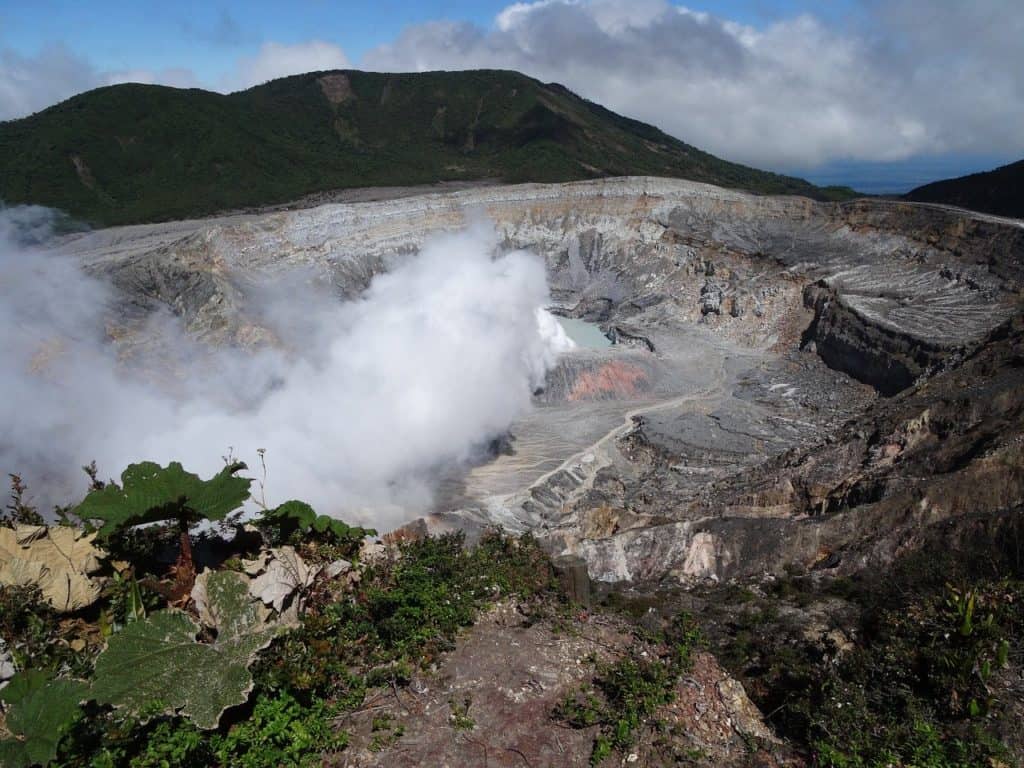
Another volcano located in Central Costa Rica and on the same mountain range as Irazu, is Poas Volcano. Much like Irazu, Poas is a very active volcano, having erupted 40 times since it was first recorded in 1828, with the most recent volcanic activity occurring in September 2019.
Poas has its own crater lakes, both of which are close to the summit. Laguna Caliente, which means Hot Lake, located on its norther side, and Lake Botos, located on its southern side. Laguna Caliente is known to be very acidic. In fact, at almost 0 pH levels, it is known to be one of the most acidic lakes in the entire world. So much so, that there is little to no aquatic life in it.
In contrast, Lake Botos, which is a crater that hasn’t erupted in more than 9,000 years, is clear and cool, capable of supporting at least 23 species of algae. In fact, visitors to the Poas Volcano National Park can pretty much walk up to it safely from the trail and take pictures.
3. Rincon De La Vieja Volcano
Rincon De La Vieja, whose name means “Old Woman’s Corner”, is located in northwestern Costa Rica, in the province of Guanacaste, near the city of Liberia.
It’s an active volcano steeped in legend, with its very name being associated with a local legend involving the love affair of a princess named Curabanda and Mixcoac, her lover who was a member of an enemy tribe. Curabanda’s father eventually found out about the relationship and had Mixcoac executed by throwing him into the volcano’s crater.
Heartbroken, the princess spent the rest of her days on the side of the volcano, becoming a reclusive old lady.
Legends aside, Rincon De La Vieja is also known to be a geologically active location, producing a significant amount of geothermal energy. Potentially, the volcano is capable of producing 140 megawatts of power for Costa Rica. Unfortunately, since the volcano itself is located inside a national park, geothermal energy plants aren’t allowed to be built there.
This geothermal energy also takes the form of hot springs, of which the areas surrounding the volcano is dotted with. A tourism industry has pretty much grown from the national park surrounding the volcano, with many hotels, resorts, walking trails and tours located around the volcano.
4. Barva Volcano
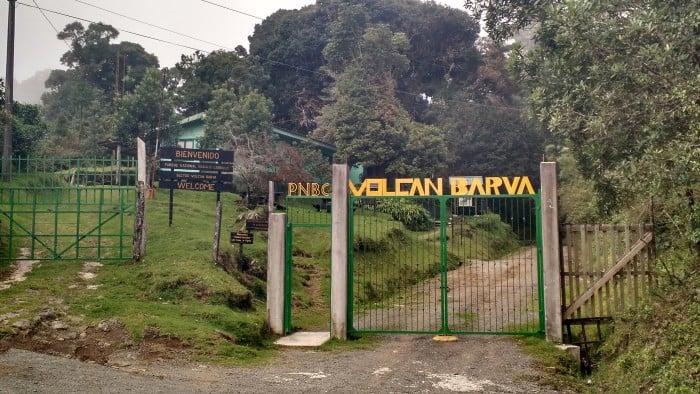
Barva Volcano is a dormant volcano located in central Costa Rica, just north of the capital, San Jose. There is currently a lake where the volcano’s crater used to be, which is called Laguna de Brava, or Brava Lake. Another distinguishing feature are the three hills on the volcano’s western side. The hills are named Las Tres Marias, or “The Three Marys”.
Barva is no longer active, with its most recent eruption being 8,000 years ago. There have been reports that the volcano had erupted in the 1760’s, as well as on 1867, but the lack of evidence means that these reports remain unverified.
Since the volcano hasn’t been known to be active, a small agricultural town called Sacramento has popped up here. The town itself has recently become a popular weekend spot and staging ground for many local and international tourists looking to explore the national park at Barva Volcano’s base.
5. Tenorio Volcano
Located in northwestern Costa Rica, in the border of Alajuela and Guanacaste provinces, Tenorio Volcano is an inactive volcano, which is part of the Tenorio Volcano National Park.
The volcano itself is composed of four peaks, with two craters. One of these craters is sometimes referred to as Montezuma Volcano, though many volcanologists believe it’s a part of Tenorio, and not a separate volcano.
Tenorio is about 6,200 feet tall, surrounded by lush rainforest and cloud forests closer to the summit, all of which are home to tapirs and the rare Puma. Three rivers, namely the Tenorio, the Tenorito and the Martirio, have their sources within Tenorio Volcano.
6. Turrialba Volcano
The Turrialba Volcano is an active volcano located in central Costa Rica, within the Cordillera mountain range. It is the easternmost of Costa Rica’s active volcanos, and is adjacent to Irazu Volcano, which is also a very active volcano. The volcano itself has erupted multiple times in the past, with the most recent being in April 2017.
Turrialba Volcano is known for its violently explosive eruptions, with some eruptions being recorded to send volcanic material to towns 40 km away. Despite its highly active nature, however, there is a thriving montane forest along the face of the volcano, home to many species of ferns, mosses and bromeliads.
Alongside its neighbor, Irazu, Turrialba is one of the tallest volcanos of Costa Rica, towering at a whopping 10,958 feet tall. Much like Irazu, it’s also possible to see the Atlantic and the Pacific Oceans from the summit, provided it’s not cloudy.
The name Turrialba itself is shrouded in mystery, with experts not being able to agree on its origins. It could be from Torrealba, a district in Aragon, Spain, or from the Latin phrase Turris Alba, meaning white tower. Some experts even argue that the word might even have roots in the native Huetar language.
7. Arenal Volcano
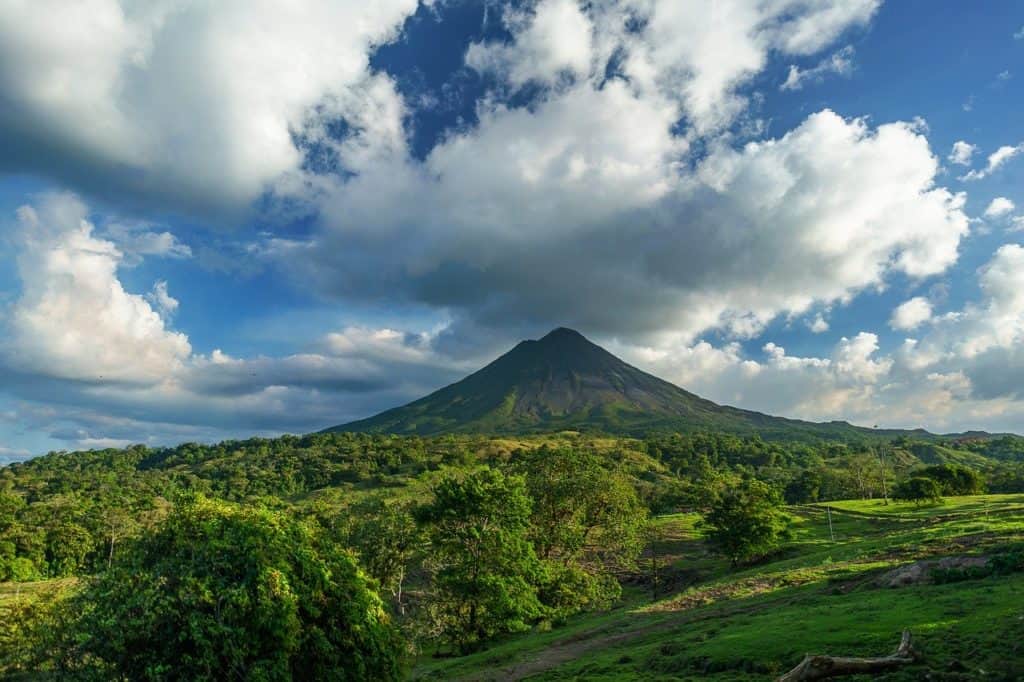
The Arenal Volcano is one of many active volcanos in the country, located in Northwest Costa Rica. It’s located about 90 km from the capital San Jose and is considered to be the youngest volcano in Costa Rica, in geological terms, being only 7,500 years old.
It is Costa Rica’s most infamous volcano and is known by many names, including Canaste, Pan de Azucar, Volcan Costa Rica and Guastusos Peak. For most of its known history, it has been a dormant volcano, but an unexpected eruption in 1968 quickly changed that designation. The 1968 eruption itself destroyed the neighboring town of Tabacon.
After 1968, Arenal has become a very active volcano, erupting 8 times since then, with 5 of those eruptions occurring within a 5-year span from 1993 to 1998.
It culminated into the May 7, 1998 eruption, where 23 eruptions were recorded in a 6-hour period, destroying a 2km area of forest around the volcano, and creating a large fissure at its base. After these volcanic activities, Arenal suddenly calmed down in the 2000’s, and by the 2010’s, it seemed to have entered dormancy.
Despite the dangers Arenal Volcano poses, the surrounding area is a known tourist destination, with many hot spring resorts dotting the area. The national park is also home to a diverse collection of species.
Final Thoughts
Costa Rica is a country full of natural beauty. You might know it as the destination where you can find lots of beautiful beaches and amazing wildlife.
However one natural phenomena that stands out worth visiting when in Costa Rica are the Volcanoes and seeing 1 if not all of them can be the highlight of any trip to Costa Rica.

